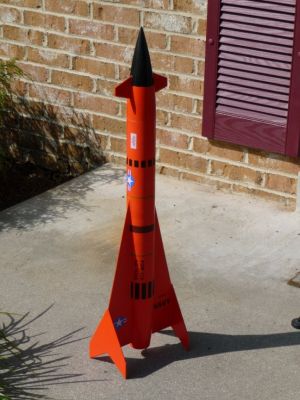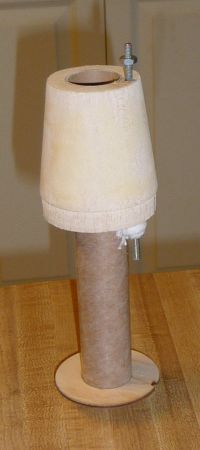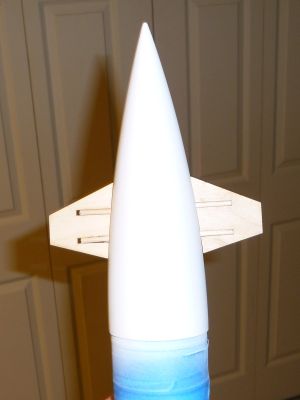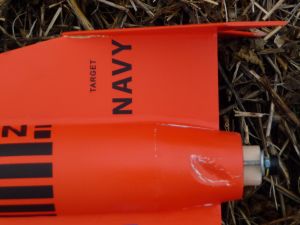Madcow Rocketry AQM-37 Jayhawk
Madcow Rocketry - AQM-37 Jayhawk {Kit} (K-109)
Contributed by Dick Stafford
| Construction Rating: | starstarstarstarstar_border |
| Flight Rating: | starstarstarstarstar_border |
| Overall Rating: | starstarstarstarstar_border |
| Diameter: | 2.60 inches |
| Length: | 30.75 inches |
| Manufacturer: | Madcow Rocketry  |
| Style: | Scale |
Brief:
This is a nice scale model of the Navy's AQM-37 Jayhawk. It features high quality components and flies on 29mm
motors. The kit has been upgraded with a plastic nose cone since the prior review.


Construction:
The parts list:
- Plastic nose cone and screw eye
- Balsa tail cone
- Pre-slotted 2.6" body tube
- One plywood centering ring
- 29mm motor tube
- Laser-cut fins, winglets, and canards
- 1/8" dowel
- Combination of Kevlar® and nylon shock cord sections
- 9" x 9" chute protector
- 30" Nylon chute
- ¼" launch lugs
- Waterslide decal set

The kit came with 7 pages of instructions. These are not as extensive as some but are more than adequate for even relatively inexperienced builders. Even though the design is somewhat exotic, the precision components made this a relatively easy build. I used 5-minute epoxy everywhere but on the fin/winglet interface.
You start with the motor mount, which consists of the tail cone, motor mount, and a forward centering ring. I decided that I wanted to add positive retention so I attached all-thread atop of a thin spacer to the motor mount. This required that I notch the tail cone but this was easily accomplished.
The Kevlar® portion of the shock tether is tied around the motor mount and epoxied to the centering ring. It fits in a notch on the ring and is tied to the nylon cord. The main trick up to this point is to not obstruct the fin tabs.
The motor mount and fin installation was straightforward, due in a large part to the precision laser cutting. The issue here is the attachment of the side winglets. Madcow warns that they tend to snap off on landing and offers two options. One is to attach them lightly so they will snap off easily and without damage. The other option is to try to make them bulletproof. I thought about using a larger chute (and probably will anyway) but decided the snap away idea is the way to go. I was afraid that the thin pointy tips would take a beating even if the fins stay on. You could glass them, but I didn't really want to.
 The nosecone build was interesting. Due to the problems associated with attaching parts to
the plastic cone, the canards employ a unique mounting technique. You drill holes in the cone and insert the provided
dowel (cut in half). These dowels mate with slots in the canards so the structural support is independent of the bond
with the plastic. I had two problems but neither affected the results. First, the dowel provided was warped and if you
cut it to the specified lengths they are about 1/8" short. I contemplated buying a replacement but just made it
work.
The nosecone build was interesting. Due to the problems associated with attaching parts to
the plastic cone, the canards employ a unique mounting technique. You drill holes in the cone and insert the provided
dowel (cut in half). These dowels mate with slots in the canards so the structural support is independent of the bond
with the plastic. I had two problems but neither affected the results. First, the dowel provided was warped and if you
cut it to the specified lengths they are about 1/8" short. I contemplated buying a replacement but just made it
work.
The instructions provide the target CG and instructs you to add nose weight to move the CG to a point 19" from the nose cone's tip. They recommend adding the weight to the shoulder section as weight in the tip is subject to coming loose. I first determined the amount of shot by placing it in a sandwich bag and draping it over the rocket at the rear end of the cone's shoulder. I then added lead shot and epoxy through a ½" hole drilled in the cone's shoulder. My completed model weighs in at 25oz. I noticed this is a little heavier than the other reviewer's model and quite a bit over the quoted number.
Finally, I added two orange colored buttons from railbuttons.com in lieu of the provided lugs.
Finishing:
I first sealed the wood parts and filled the thin spirals with Elmer's Fill 'n' Finish. The instructions referred to
newer plastic primers for the plastic cone. I'd had never used any and thought I'd try Rustoleum Plastic primer. I
initially painted the nose cone tip with Krylon H2O black. H2O over plastic primer seemed like a good idea. After that
had dried, I masked the tip and shot Plasti-Kote primer on the canards and over the plastic primer on the base. Primer
over primer? This worked OK and saved masking the base of the cone. I then shot Testor's Competition Orange on. So far
so good. Then, however, the Frog Tape that I used to mask the tip lifted 50% of the H2O off. I removed the rest and
repainted with the only other black I had on hand--Rustoleum Hammered Black. I sprayed this into the plastic top from a
pack of Estes engines and brushed it on. The cone actually turned out OK.
The body was more straightforward with Plasti-Kote primer and Testor's Competition Orange. The kit comes with a lot of decals and they are good quality. I did a lot of repositioning and the only problem was one small corner folded under. As I was trying to unfold it, the edge broke off. Barely noticeable.
I rate this build a 4. The canard dowels were not perfect but everything else was top notch.
Construction Rating: 4 out of 5

Flight:
I flew the Jayhawk at MDRA's Red Glare V launch. All the recommended motors are Fs so I opted for an F42-4 EconoJet
for the maiden flight. The -8 seemed too long and I'd rather see the delay too short than too long. I used a tape
thrust ring in lieu of the F42's cardboard ring and added a small washer on the retention bolt. I upgraded to a
42" chute and added the provided one to the range box supply. The boost was very straight in the perfectly calm
winds and, as typical for "winged" sport rockets, performed a slight wiggle after burn out.
Recovery:
Ejection was early and, because the cone is so heavy, the body slammed into it. Luckily, no fins were stripped by the
impact but the balsa tail cone had a nice divot that looked like it might have been made by the screw eye in the base
of the cone. This seemed a little odd since it was on a surface tapering away from the body.
Despite the bigger chute, the fillets on both winglets both had stress cracks in their fillets. Although not totally unexpected, I thought the bigger chute and soft plowed ground would have spared them.
 I won't ding the kit's rating for the impact as this was user error and the cracks in the
fillets were due to my chosen build technique. However, my general sense is that this kit is more subject to landing
damage unless you went hog wild in its construction.
I won't ding the kit's rating for the impact as this was user error and the cracks in the
fillets were due to my chosen build technique. However, my general sense is that this kit is more subject to landing
damage unless you went hog wild in its construction.
Flight Rating: 4 out of 5
Summary:
PROs:
- This is an awesome looking kit.
- Despite its unique looks, it is quite stable.
- Precision cut parts/quality recovery components.
- Nice method of attaching the canards to the plastic cone.
- Nice decals.
CONs
- Winglets are asking to snap off.
- Chute is undersized.
- Should provide motor retention.
I'm repairing the fillets, filling the divot, and will fly her on a G71 next. I'm probably going to use a separate chute for the cone.
Overall Rating: 4 out of 5
Other Reviews
- Madcow Rocketry AQM-37 Jayhawk By Drake "Doc" Damerau (March 15, 2007)
Brief: The Madcow Rocketry AQM-37 Jayhawk is a high quality mid-powered kit that is a close scale to the US Navy’s target drone. Construction: The parts list: 2.6” heavy wall body tube Aircraft plywood fins and centering rings Shock cord, chute, and even a Nomex ® heat shield Balsa nose cone with unusual ballast compartment High quality ...
 |
 |
Flights
Sponsored Ads
 |
 |











